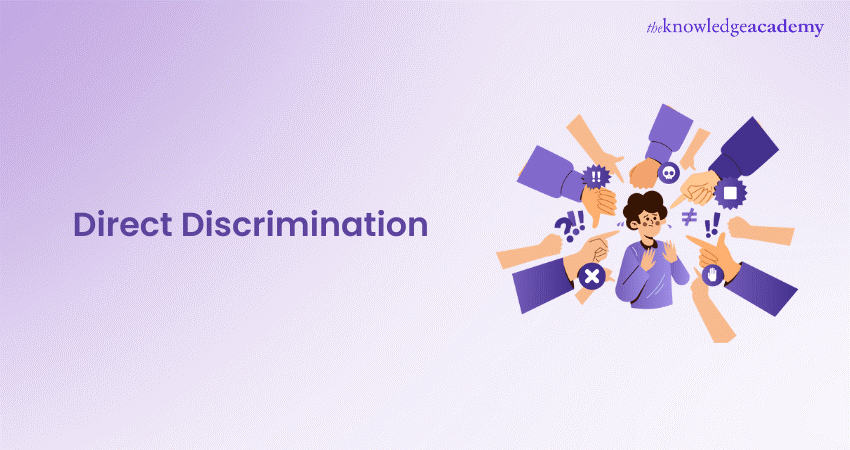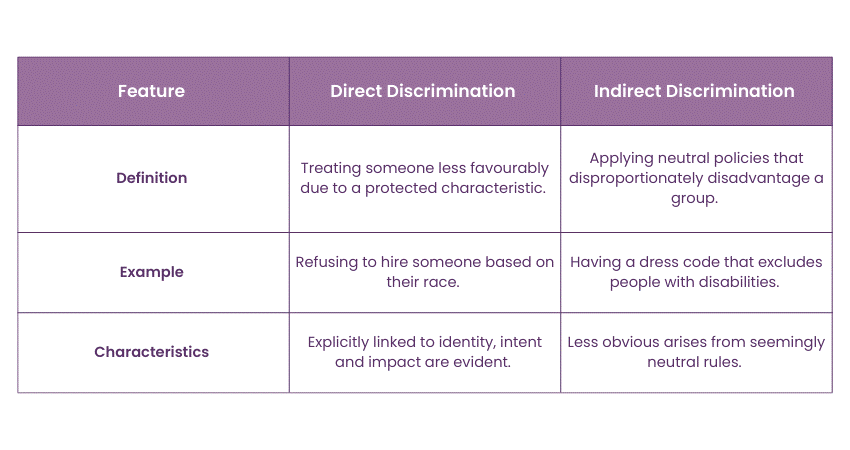We may not have the course you’re looking for. If you enquire or give us a call on 01344203999 and speak to our training experts, we may still be able to help with your training requirements.
Training Outcomes Within Your Budget!
We ensure quality, budget-alignment, and timely delivery by our expert instructors.

Have you ever felt sidelined because of your identity rather than your abilities or potential? You might be experiencing Direct Discrimination. Discrimination has become a crucial resistence to equality and progress in the global ecosystem. Based on the European Union Agency for Fundamental Rights report, 77% of people of African descent reported racial discrimination and harassment in EU member states. But worry not! In this blog, we will understand what Direct Discrimination is exactly, its importance, types, examples, ways to prevent, and its major differences from indirect discrimination. Wasting no time—let's proceed!
Table of Contents
1) What is Direct Discrimination?
2) Importance of Addressing Direct Discrimination
3) Different Types of Direct Discrimination
4) How Can Discrimination Affect Your Business?
5) Direct vs Indirect Discrimination: Key Differences
6) How to Prevent Direct Discrimination in Your Organisation
7) Conclusion
What is Direct Discrimination?
Direct discrimination is a legal concept that describes the unjust treatment of an individual based on a protected characteristic, such as age, race, gender, disability, or sexual orientation. It happens when someone is treated less favorably than another person in a comparable situation because of these characteristics.
Importance of Addressing Direct Discrimination
Curbing Direct Discrimination is much more important than you think. In fact, it's a necessity today. The importance of addressing Direct Discrimination is described below:
1) Addressing Direct Discrimination fosters a fair and inclusive society with equal opportunities for all.
2) It prevents the denial of essential resources, opportunities, and support based on identity.
3) Addressing discrimination supports personal and professional growth.
4) It promotes creativity and innovation through diverse perspectives.
5) Curbing discrimination can promote a positive workplace culture, further boosting morale and productivity.
6) It emphasises the commitment to diversity and a supportive environment.
7) Addressing discrimination also improves Employee Engagement and retention by recognising contributions and honouring deserving candidates.
8) It acts as a strategic imperative driving social justice and organisational success.
Different Types of Direct Discrimination
There are various types of Direct Discrimination. We have described them below:
1) Age Discrimination: This occurs when individuals are mistreated because of their older or younger age. Prevalent examples include older employees being overlooked for promotions or younger candidates being dismissed as inexperienced.
2) Gender Discrimination: This happens when someone is treated less favourably because of their separate genders. For instance, woman is paid less comparative to their male competitors for the same job or being denied opportunities for advancements and promotion in the same organisation where males are working.
3) Disability Discrimination: This type of discrimination consists of individuals with disabilities and are facing unfair treatment in the workplace or society. It could include employers failing to provide reasonable accommodation or excluding them from getting a job.
4) Racial or Ethnic Discrimination: Such discrimination occurs when people are not treated fairly because they are from different races or backgrounds.
5) Religious Discrimination: Religious discrimination comprises unfair treatment based on a person’s beliefs or practices. Key examples include employees being denied time off for religious holidays or facing harassment owing to their religious attire.
Become an anti-bribery specialist- join our Anti-Bribery Course today!
How Can Discrimination Affect Your Business?
Direct Discrimination can affect your business in multiple ways. Below, described are a few of those impacts:
1) Discrimination can reduce employee productivity, as marginalised individuals are less likely to engage completely in their work.
2) It can cause higher turnover rates, with talented Employees leaving for a better work culture.
3) Businesses that fail to address discrimination may suffer from reputational damage leading to customer loss and hindering brand loyalty.
4) Consumers favour companies that stress the commitment to diversity and inclusion in today’s socially conscious market.
5) Combating discrimination is crucial to maintain a competitive edge and develop a positive workplace culture.
Fuel your people management skills with our Talent Management Training – sign up today!
Direct vs Indirect Discrimination: Key Differences
The differences between Direct and Indirect Discrimination are illustrated below:

1) Definition
a) Direct Discrimination: Direct Discrimination is when an individual is not treated favorably because of their characteristics, such as separate race, gender, age, or disability.
b) Indirect Discrimination: While indirect discrimination Involves policies or practices that may seems neutral or normal from a generalised perception but is causing disadvantage to a certain group of individuals.
2) Examples
a) Direct Discrimination: An employer refusing to hire a qualified candidate solely because they are from a different religion.
b) Indirect Discrimination: A company dress code orders for specific types of shoes that unintentionally disadvantages individuals with disabilities who are from Muslim background.
3) Characteristics
a) Direct Discrimination: The intent and impact are evident, as the unfair treatment is explicitly linked to the individual’s identity.
b) Indirect Discrimination: Less obvious and often arises from rules that apply to everyone but have a negative impact on certain individuals.
Master performance evaluation techniques with our Performance Appraisal Training- register today!
How to Prevent Direct Discrimination in Your Organisation?
To prevent Direct Discrimination in your organisation, you must implement the following pointers:
1) Companies should implement stronger anti-discrimination policies that highlights unacceptable behaviours and formalise stricker consequences for violations.
2) They should also conduct training programs to educate employees about diversity, equity, and inclusion.
3) Companies should promote transparent hiring and promotion processes based on qualifications and merit rather than their individualised identities.
4) Organisations should review hiring and promotion processes regularly to identify and address any kind of biases.
5) They should encourage open dialogue about discrimination and provide channels for reporting incidents without fear of retaliation.
6) They must empower a culture of respect and equality to create a workplace where everyone feels valued and motivated to contribute to the organisational growth.
Conclusion
We hope you understand Direct Discrimination. Addressing Direct Discrimination is important for employees in an organisation that cultivates an inclusive workplace and values diversity and equal opportunities. In addition, organisations can significantly enhance employee morale, empower innovation, and ultimately lead to greater success in a competitive ecosystem.
Lead with effective workforce planning- book your seats for ours Workforce Resource Planning Training!
Frequently Asked Questions

No, Direct Discrimination cannot be justified in any way. It involves treating individuals unfairly on the basis of their characteristics like race, gender, or age, rather than their abilities. Such discrimination undermines equality and inclusivity, violating human rights principles.

You can raise the issue with HR or management to challenge Direct Discrimination, citing your rights under anti-discrimination laws. Seek support from colleagues or advocacy groups and consider filing a formal complaint if necessary. Lastly, encourage awareness and training on diversity and inclusion within your organisation.

The Knowledge Academy takes global learning to new heights, offering over 30,000 online courses across 490+ locations in 220 countries. This expansive reach ensures accessibility and convenience for learners worldwide.
Alongside our diverse Online Course Catalogue, encompassing 19 major categories, we go the extra mile by providing a plethora of free educational Online Resources like News updates, Blogs, videos, webinars, and interview questions. Tailoring learning experiences further, professionals can maximise value with customisable Course Bundles of TKA.

The Knowledge Academy’s Knowledge Pass, a prepaid voucher, adds another layer of flexibility, allowing course bookings over a 12-month period. Join us on a journey where education knows no bounds.

The Knowledge Academy offers various Employment Law Courses, including Direct and Indirect Discrimination Training, Anti-Bribery Training Course, and Employment Law Training. These courses cater to different skill levels, providing comprehensive insights into Employee Rights and Responsibilities.
Our HR Resources Blogs cover a range of topics related to human resource management, offering valuable resources, best practices, and industry insights. Whether you are a beginner or looking to advance your HR skills, The Knowledge Academy's diverse courses and informative blogs have got you covered.
Upcoming HR Resources – Learn about Human Resources Batches & Dates
Date
 Direct and Indirect Discrimination Training
Direct and Indirect Discrimination Training
Fri 24th Jan 2025
Fri 28th Mar 2025
Fri 23rd May 2025
Fri 25th Jul 2025
Fri 26th Sep 2025
Fri 28th Nov 2025







 Top Rated Course
Top Rated Course



 If you wish to make any changes to your course, please
If you wish to make any changes to your course, please


